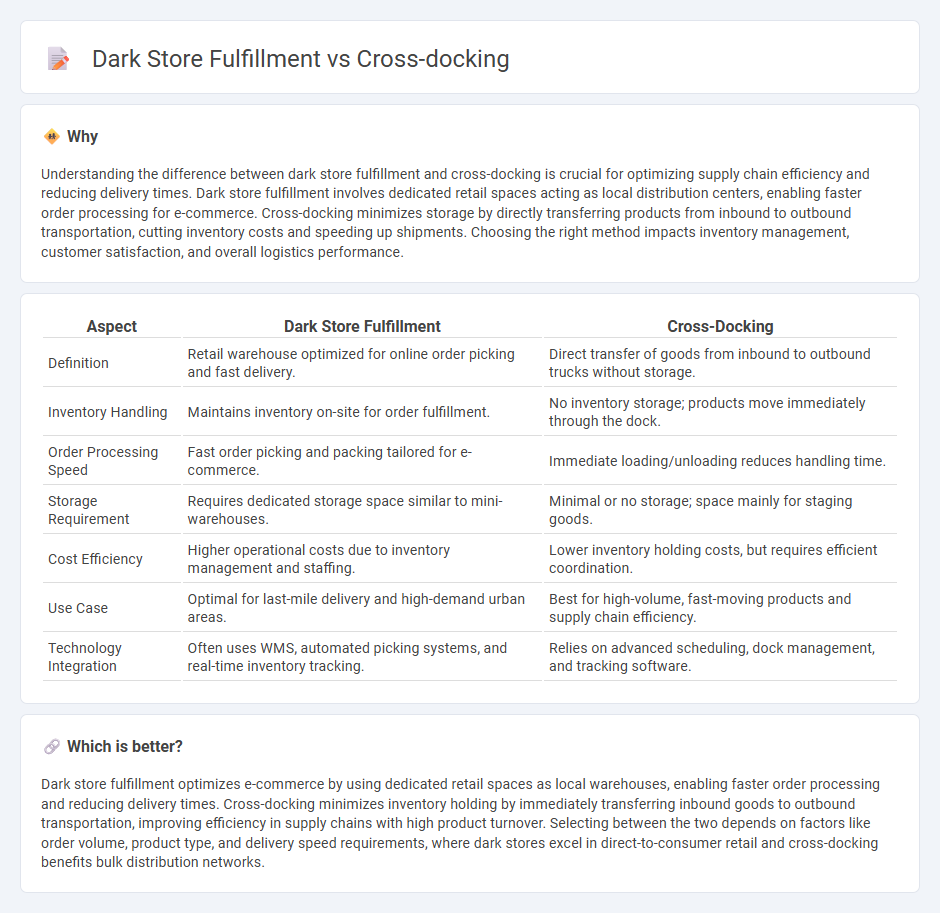
Dark store fulfillment focuses on storing inventory in dedicated, small-scale warehouses designed for rapid e-commerce order processing, enhancing delivery speed and reducing last-mile costs. Cross-docking streamlines logistics by directly transferring incoming goods to outbound transportation, minimizing storage time and accelerating supply chain efficiency. Discover the advantages and applications of both methods to optimize your logistics strategy.
Why it is important
Understanding the difference between dark store fulfillment and cross-docking is crucial for optimizing supply chain efficiency and reducing delivery times. Dark store fulfillment involves dedicated retail spaces acting as local distribution centers, enabling faster order processing for e-commerce. Cross-docking minimizes storage by directly transferring products from inbound to outbound transportation, cutting inventory costs and speeding up shipments. Choosing the right method impacts inventory management, customer satisfaction, and overall logistics performance.
Comparison Table
| Aspect | Dark Store Fulfillment | Cross-Docking |
|---|---|---|
| Definition | Retail warehouse optimized for online order picking and fast delivery. | Direct transfer of goods from inbound to outbound trucks without storage. |
| Inventory Handling | Maintains inventory on-site for order fulfillment. | No inventory storage; products move immediately through the dock. |
| Order Processing Speed | Fast order picking and packing tailored for e-commerce. | Immediate loading/unloading reduces handling time. |
| Storage Requirement | Requires dedicated storage space similar to mini-warehouses. | Minimal or no storage; space mainly for staging goods. |
| Cost Efficiency | Higher operational costs due to inventory management and staffing. | Lower inventory holding costs, but requires efficient coordination. |
| Use Case | Optimal for last-mile delivery and high-demand urban areas. | Best for high-volume, fast-moving products and supply chain efficiency. |
| Technology Integration | Often uses WMS, automated picking systems, and real-time inventory tracking. | Relies on advanced scheduling, dock management, and tracking software. |
Which is better?
Dark store fulfillment optimizes e-commerce by using dedicated retail spaces as local warehouses, enabling faster order processing and reducing delivery times. Cross-docking minimizes inventory holding by immediately transferring inbound goods to outbound transportation, improving efficiency in supply chains with high product turnover. Selecting between the two depends on factors like order volume, product type, and delivery speed requirements, where dark stores excel in direct-to-consumer retail and cross-docking benefits bulk distribution networks.
Connection
Dark store fulfillment relies on efficient inventory management by storing products closer to urban consumers, enabling rapid order processing and last-mile delivery, which complements cross-docking operations that minimize storage time by directly transferring goods from inbound to outbound transportation. Both strategies optimize supply chain speed and reduce warehousing costs by streamlining the flow of goods and enhancing order accuracy. Integrating dark stores with cross-docking centers improves logistics efficiency in e-commerce and retail distribution networks.
Key Terms
**Cross-docking:**
Cross-docking optimizes supply chain efficiency by minimizing storage time, where products move directly from inbound to outbound transportation with little to no warehousing. This method reduces inventory holding costs and accelerates delivery times, crucial for perishable goods and just-in-time inventory models. Explore the benefits and strategic applications of cross-docking to enhance distribution performance.
Transshipment
Cross-docking streamlines transshipment by minimizing storage time and directly transferring inbound goods to outbound transportation, enhancing supply chain efficiency and reducing delivery lead times. Dark store fulfillment supports transshipment through a localized inventory model tailored for rapid order picking and last-mile delivery, optimizing urban logistics and customer satisfaction. Explore deeper into how transshipment strategies in cross-docking and dark store systems revolutionize modern fulfillment operations.
Just-in-time (JIT)
Cross-docking streamlines inventory by transferring products directly from inbound to outbound transportation, reducing storage time and supporting Just-in-Time (JIT) delivery for faster order fulfillment. Dark store fulfillment utilizes strategically located, non-retail warehouses optimized for rapid picking and packing, enhancing JIT capabilities in urban e-commerce environments. Explore deeper insights on optimizing JIT strategies with cross-docking and dark store models.
Source and External Links
Cross Docking: Definition, History, and Process - Inbound Logistics - Cross docking is a shipping method that transfers goods directly from inbound to outbound transportation with minimal storage, using methods like continuous cross docking, consolidation, and de-consolidation for efficiency and cost reduction.
What Is Cross-Docking? Definition, Types & Advantages - NetSuite - Cross-docking is a supply chain technique that directly transfers goods from inbound to outbound vehicles at a logistics facility, minimizing storage to speed delivery, reduce costs, and optimize inventory control.
Understanding cross-docking: A comprehensive guide - Maersk - Cross-docking involves minimal storage by quickly transferring products from suppliers to customers, with types including pre-distribution, post-distribution, continuous, consolidation, and deconsolidation tailored for retail, manufacturing, and e-commerce needs.
 dowidth.com
dowidth.com